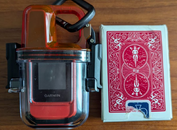hammet
Contributor
I was playing with the the fixed mount vhf AIS capable (receive only) radio on my boat this morning. Also checking the manual.... There is no ability to distinguish AIS distress transmissions. There's nothing in any Icom of Standard Horizon manuals about receiving AIS distress signals on even the latest models. Although I've received a few DSC distress calls in the past (they come over vhf channel 70 with an alert sound like the t.v. emergency broadcast system) , Ive never seen something specifically just over AIS.
I wonder how my radio would pick up an AIS distress from one of these resqlink devices.
Interesting...
20. Can I use AIS in an emergency or for distress messaging? Although not prohibited (see 33 CFR § 164.46(d)(3)), be aware that AIS safety related text messages nor AIS locating devices (i.e. AIS MOB devices)are not currently monitored or acted upon as Global Maritime Distress Safety Systems (GMDSS) alert messages by the Coast Guard Rescue 21 or other maritime search and rescue authorities or systems. Therefore, AIS should not be relied upon as the primary means for broadcasting distress or urgent communications, nor used in lieu of GMDSS devices such as Digital Selective Calling (DSC) radios which are designed to process distress messaging. Nonetheless, AIS remains an effective means to augment GMDSS and provides the added benefit of being seen by other AIS users and USCG assets within AIS radio range, in addition to being heard via AIS text messaging. For further guidance, see USCG Safety Alert 5-10. Also, see the International Maritime Organization’s (COMSAR) Circular 46, Use Of AIS Safety-Related Messaging In Distress Situations.
Consumers interested in Man Overboard (MOB) or Personal Locating Beacon (PLB) devices should pay particular attention to their mode of operation, i.e. sole DSC distress alerting, sole AIS transmitters, dual AIS-DSC, or as private network devices. Owners of any AIS locating or DSC alerting devices should ensure they are well maintained, at the ready, and, stored or fitted in such a manner that mitigates their accidental activation. Inadvertent activations should be reported immediately to the pertinent Coast Guard District or Regional Command Center.
I wonder how my radio would pick up an AIS distress from one of these resqlink devices.
Interesting...
20. Can I use AIS in an emergency or for distress messaging? Although not prohibited (see 33 CFR § 164.46(d)(3)), be aware that AIS safety related text messages nor AIS locating devices (i.e. AIS MOB devices)are not currently monitored or acted upon as Global Maritime Distress Safety Systems (GMDSS) alert messages by the Coast Guard Rescue 21 or other maritime search and rescue authorities or systems. Therefore, AIS should not be relied upon as the primary means for broadcasting distress or urgent communications, nor used in lieu of GMDSS devices such as Digital Selective Calling (DSC) radios which are designed to process distress messaging. Nonetheless, AIS remains an effective means to augment GMDSS and provides the added benefit of being seen by other AIS users and USCG assets within AIS radio range, in addition to being heard via AIS text messaging. For further guidance, see USCG Safety Alert 5-10. Also, see the International Maritime Organization’s (COMSAR) Circular 46, Use Of AIS Safety-Related Messaging In Distress Situations.
Consumers interested in Man Overboard (MOB) or Personal Locating Beacon (PLB) devices should pay particular attention to their mode of operation, i.e. sole DSC distress alerting, sole AIS transmitters, dual AIS-DSC, or as private network devices. Owners of any AIS locating or DSC alerting devices should ensure they are well maintained, at the ready, and, stored or fitted in such a manner that mitigates their accidental activation. Inadvertent activations should be reported immediately to the pertinent Coast Guard District or Regional Command Center.




